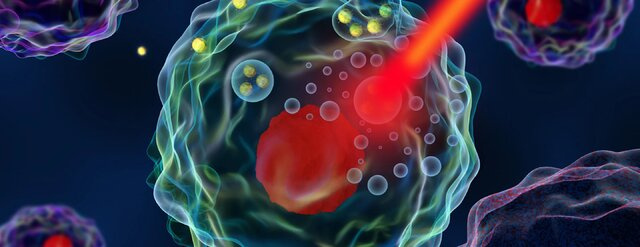By UT Researchers
Examined in a Modeling Study Thermotherapy: A Method to Terminate Cancerous Cells

The researchers of UT Faculty of New Sciences and Technologies managed to examine the impact of Thermotherapy on termination of cancerous cells in a modeling study. Thermotherapy or Hyperthermia is one of the treatment methods for cancer in which the body temperature is increased up to 45 degrees Celsius. The researches have demonstrated that high temperature can tear down the cancerous cells and terminate the tumor via harming the proteins and the intercellular structure. This method of treatment is currently being studied and tested and it has not yet been applied publically.
To perform Thermotherapy, warmth could be created through various ways including injection of a solution of magnetic nanoparticles in the tumor area and placing it in a magnetic field. The expenses of experimenting such tests inside the body of an alive species to investigate the influence of Thermotherapy are high. It is therefore customary to perform a modeling study prior to the main test to reduce costs. As a result, the researchers of UT have speculated the conditions to employ this method inside the body of alive species through implementation of a modeling study using the empirical data from experiments outside the body of alive species. Modeling study could considerably increase accuracy to speculate what happens in reality and provide better results for the researchers.
The studies indicate that the in-vivo endures heat up to 40 degrees Celsius. As the temperature rises above 43 degrees Celsius, the in-vivo gradually begins to tear down. In 50 degrees Celsius, the in-vivo is ready for complete termination. To terminate the tumor in this method, the temperature of the tumor area could be increased and maintained at 50 degrees Celsius for a certain period of time. It should also be noted that the temperature should be controlled to prevent the surrounding tissues from getting wounded.
The findings of this modeling study demonstrate that injection in the center of the tumor area could result in a more efficient treatment and much less harm to the healthy tissues of the skin due to the equal dispensation of temperature. Furthermore, temperature of a more extensive bulk of the tumor will reach 42 degrees Celsius and a more effective treatment will be achieved if the injection is not implemented all at once and it is carried out in less amounts and within various parts of the tumor. If the physicians prescribe, temperature of the solution could be matched with that of the body prior to injection and the treatment will be faster and less time will be required for Thermotherapy. As a result, it is advised to measure temperature of the solution to that of the body before the injection, considering the trivial poisonous nature of nanoparticles, to prevent possible pains, scald in the area of Thermotherapy and reduction of the treatment time for welfare of the patient.
The researchers of this study recommend that the modeling study for injection in various amounts should be implemented in a few months in order to arrive at the ideal injection spots and the optimized amount of the solution. A more accurate physical geometry of each patient could also be considered via scrutinizing the condition of the patient and employing medical imagery. The procedure of the treatment will then be speculated considering the type, size and location of the tumor.
Ms. Fatemeh Naghdabadi and Mr. Bahman Vahidi, researchers of UT Faculty of New Sciences and Technologies, have taken part in this research. This study has been performed based on the approved M.A. thesis of UT and its findings have been published in a scientific journal titled: "Analysis of effect of Thermotherapy on cancerous tissues using magnetic nanoparticles" in the scientific and research magazine of Yazd Shahid Sedoughi University of Medical Sciences in April of the current year.

Your Comment :